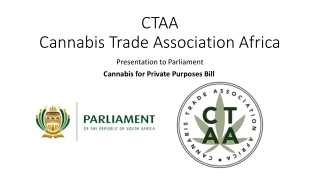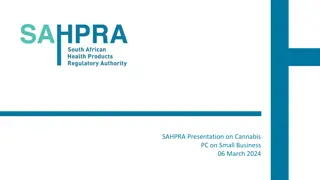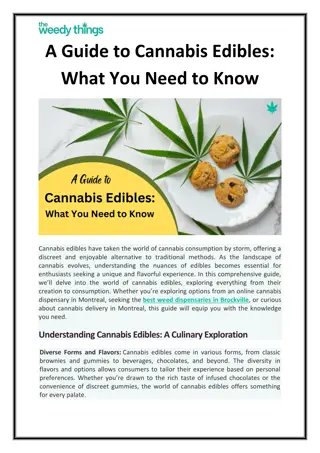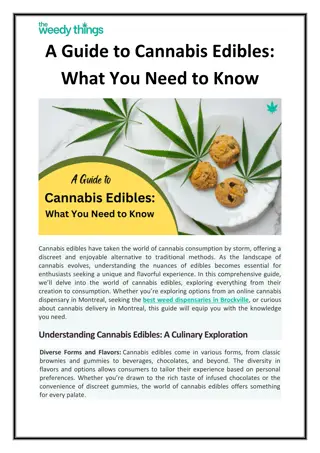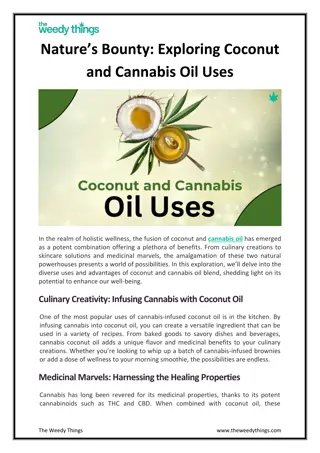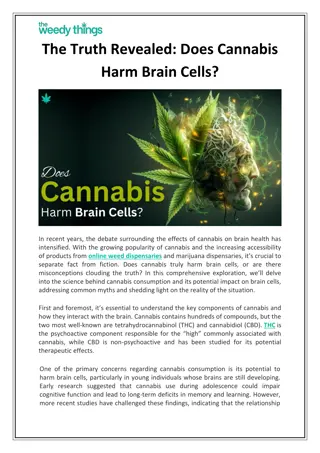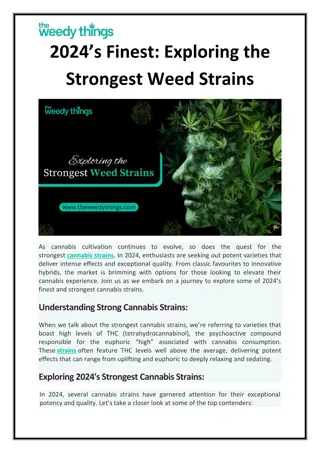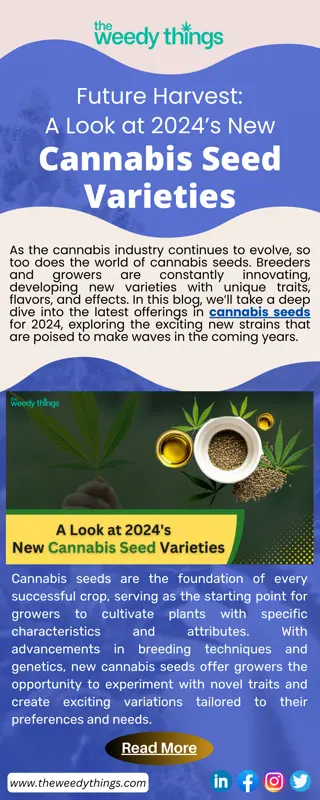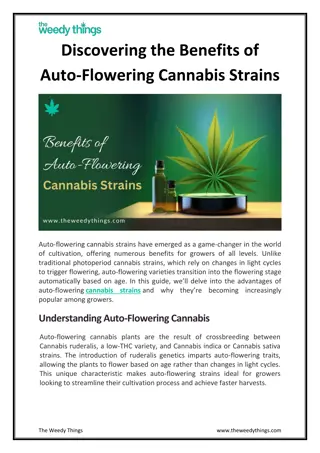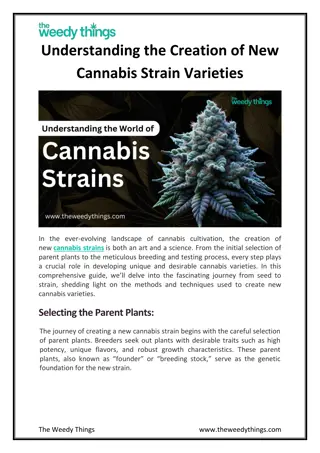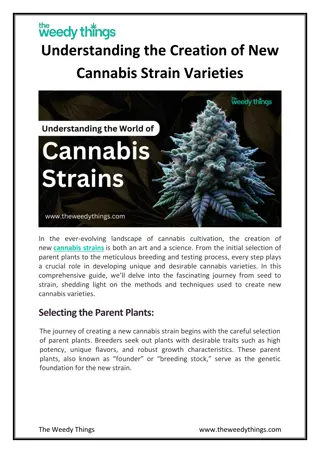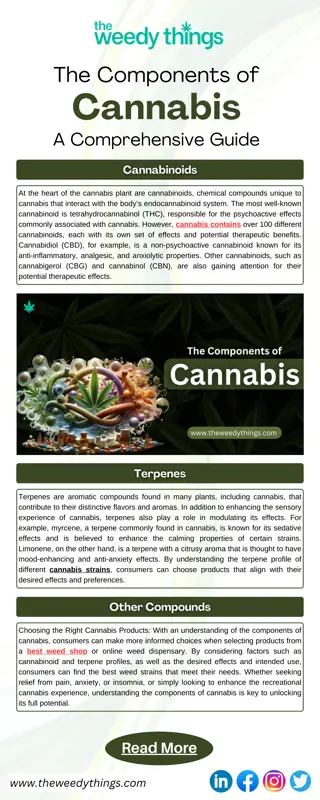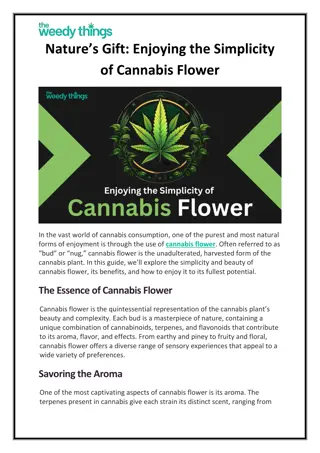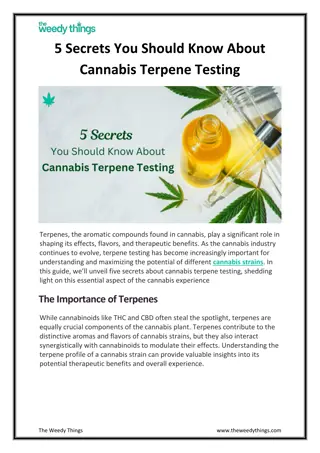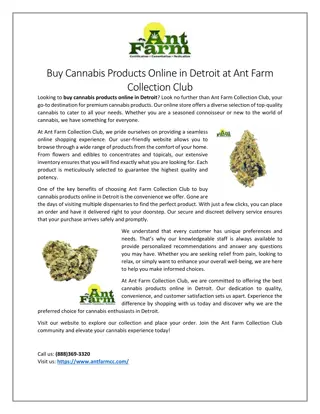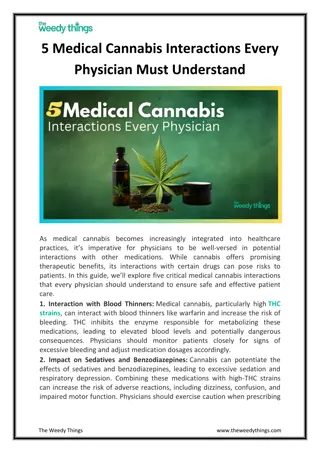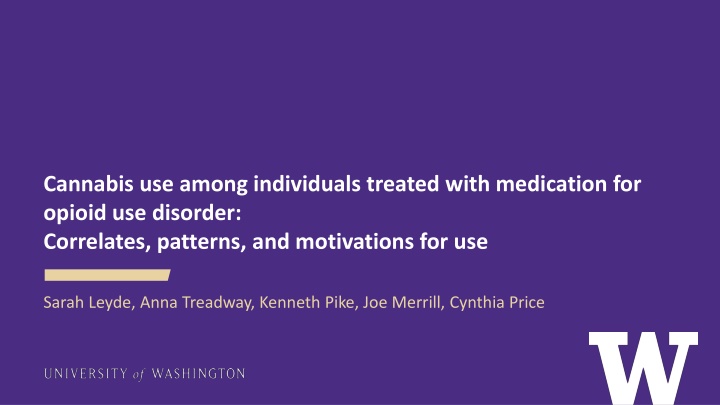
Cannabis Use Among Individuals Treated for Opioid Use Disorder: Correlates, Patterns, Motivations
This study explores the use of cannabis among individuals undergoing medication treatment for opioid use disorder, examining correlates, usage patterns, and motivations. Research indicates that cannabis use during medication-assisted treatment is not associated with adverse outcomes. The objectives include describing demographic differences and exploring usage patterns and motivations among frequent cannabis users. The methods involve analyzing baseline data from a randomized controlled trial of a mind-body adjunct treatment to medication treatment, with participants recruited from Washington state clinics.
Download Presentation

Please find below an Image/Link to download the presentation.
The content on the website is provided AS IS for your information and personal use only. It may not be sold, licensed, or shared on other websites without obtaining consent from the author. If you encounter any issues during the download, it is possible that the publisher has removed the file from their server.
You are allowed to download the files provided on this website for personal or commercial use, subject to the condition that they are used lawfully. All files are the property of their respective owners.
The content on the website is provided AS IS for your information and personal use only. It may not be sold, licensed, or shared on other websites without obtaining consent from the author.
E N D
Presentation Transcript
Cannabis use among individuals treated with medication for opioid use disorder: Correlates, patterns, and motivations for use Sarah Leyde, Anna Treadway, Kenneth Pike, Joe Merrill, Cynthia Price
Background Approximately half of individuals treated with buprenorphine or methadone for OUD use cannabis Streck et al, 2022, Substance Use & Misuse Bawor et al, 2015, Biol Sex Differences
Background Cannabis use during MOUD treatment is NOT associated with worse MOUD outcomes (retention, non-prescribed opioid use, QOL) Bagra et al, J Addiction Med, 2018 Lake et al, PLoS Med, 2019 Costa et al, Am Journ Drug Alcohol Abuse, 2024
Background Among people with active OUD, cannabis is used for: Management of opioid withdrawal Substitution of opioids for a less harmful substance Treatment of pain, insomnia, depression, anxiety There is very little research exploring how and for what reasons individuals treated with MOUD use cannabis Lake et al, Clin Psychol Review, 2020 Meacham et al, PLoS One, 2022 Lo et al, Can Jour Psychiatry, 2023 Duhart Clarke et al, Harm Reduct J, 2023
Objectives Among Among patients patients stabilized stabilized on on MOUD MOUD 1) Describe differences in demographic and clinical attributes between individuals who use cannabis frequently ( 3x/week) versus less frequently/not at all 2) Explore the use patterns and motivations of individuals who use cannabis frequently
Methods Analysis of BASELINE data from a 2 group RCT of a mind-body adjunct treatment to MOUD Recruited from 5 WA state clinics, including one OTP Inclusion criteria = Adult patients w/ MOUD dose stability* WA legalized cannabis for medicinal use in 1998, recreational in 2012 *Bup: 4 wks of MOUD and appt frequency <1x/wk *Methadone: 12 wks in treatment + min dose of 60mg + <= 3 missed doses in 30 days
MEASURES Outcome Scale Substance use 90 Day Timeline Follow-Back Depression PHQ-9 Anxiety GAD-7 PTSD PCL-5 Chronic pain presence Patient self-report of pain >3 mo Pain Severity & Interference Brief Pain Inventory (BPI) Emotional well-being/regulation Difficulties in Emotional Regulation Scale Short Form (DERS-SF) Mindfulness and interoceptive awareness Multidimensional Assessment of Interoceptive Awareness (MAIA) Physical symptoms Medical Symptom Checklist
Methods Phone survey: Participants retained in the study at 12 months who indicated frequent cannabis use
PHONE SURVEY Reasons for use (recreation, symptom management, or both) Symptoms/conditions cannabis is used to treat & whether cannabis adequately treats them Cannabis source (dispensary, street/dealer, self-grown, etc.) Routes of use (smoking, vaporizing, eating, topical, dabbing, etc.) Content of cannabis (more THC or CBD) Desire to decrease cannabis use Cannabis Use Disorder Identification Test Short Form (CUDIT-SF)
CUDIT-SF: Positive Screen = Score of 2 or higher Bonn-Miller et al, Cannabis and Cannabinoid, 2016
Results: Demographic characteristics N = 303 - Male (48%), Female (52%), Non-binary (1%) - Mean age 42.3 (12.2) - 79% white, 9% >1 race, 5% Black, 4% AI/AN, 1% Asian, 1% NH/PI - 9% Latinx - 97% reported stable housing - 66% unemployed
Results: Demographic characteristics by cannabis use frequency - No significant differences in gender identity, age, race, ethnicity, or housing by cannabis use frequency Frequent cannabis use was associated with unemployment - Total No or infrequent cannabis Cannabis 3x weekly P Employment 0.03 Unemployed 199 (66%) 138 (62%) 61 (75%) Working (full or part-time) 104 (34%) 84 (38%) 20 (25%)
Results: Clinical characteristics N = 303 48% used cannabis in the last 90 days 27% used cannabis 3x weekly High rates of abstinence from non-cannabis substances and heavy drinking 90 day follow-back: Days abstinent from opioids = 96% 90 day follow-back: Heavy drinking + other substance use = 88% 97% were retained in MOUD care 12 months Common co-occurring conditions: Depression (49%) Anxiety (40%), PTSD (41%), chronic pain (57%)
Results: Clinical characteristics by cannabis use frequency - No significant differences in MOUD type, treatment retention, non-prescribed substance use, heavy alcohol use, pain severity, pain interference, depression, PTSD, physical symptom frequency, insomnia, fatigue, interoceptive awareness, emotional regulation Frequent cannabis use was associated with anxiety and nausea/vomiting Total Cannabis 3x weekly Cannabis 3x weekly P Anxiety* 121(40%) 81 (37%) 40 (49%) 0.04 N/V <0.001 0.7 (0.9) 0.6 (0.8) 1.1 (1.1) - *mod-severe anxiety by GAD-7
Multivariable Logistic Regression of Frequent (3x weekly) Use of Cannabis 95% CI Odds Ratio P value Lower Upper Characteristic Age 1.00 0.98 1.02 0.86 Male 1.41 0.82 2.42 0.22 Education High school or above 0.68 0.40 1.18 0.17 Employed 0.54* 0.29 0.99 0.049 Anxiety 1.49 0.84 2.64 0.17 % Days abstinent heavy drinkinga 0.85 0.69 1.06 0.15 % Days abstinent non Rx opioidsa 1.22 0.98 1.53 0.08 % Days abstinent non-Rx non-opioid drug usea 0.92 0.82 1.02 0.12 MAIA (total) 0.64* 0.43 0.96 0.03 Physical Symptom Frequency (MSC) 1.33 0.77 2.29 0.31 Variables in model: age, sex, education, employment, anxiety, % days w/o heavy drinking, % days abstinent from non-Rx d opioid use, % days abstinent from non-Rx d substance use (except cannabis), MAIA, MSC frequency total
Results: Phone Survey Response Rate = 63% (N=27) 10 unreachable 1 declined to participate 1 no longer met criteria for frequent cannabis use
Survey Results: Reasons for cannabis use Recreation +Symptom management (56%) Recreation Only (15%) Symptom management only (30%)
100 90 80 70 60 50 40 30 20 10 0 % of participants who use cannabis to manage symptom/condition % of participants who indicate that cannabis adequately manages symptom/condition
Survey Results: Method of Obtaining 4 15 30 96 Cannabis dispensary/store Family member or friend Prescription/authorization The street/dealer
Survey Results: Cannabis Content 4 4 30 63 More THC than CBD About the same THC and CBD More CBD than THC Unsure
Survey Results: Route Route Total Smoking 25 (93%) Vaporizing 17 (63%) Eating 14 (52%) Topical 13 (48%) Drinking 9 (33%) Dabbing 6 (22%)
Results: Cannabis Use Disorder Screen 52% of participants indicated that they wanted to cut down or discontinue cannabis use 42% screened positive for cannabis use disorder on the CUDIT-SF*
CUDIT-SF: Positive Screen = Score of 2 or higher Bonn-Miller et al, Cannabis and Cannabinoid, 2016
Conclusions Among Among patients patients stabilized stabilized on on MOUD MOUD Cannabis use is common and is often used to treat stress, pain, and mental health conditions Higher interoceptive awareness/mindfulness and employment were associated with a lower odds of frequent cannabis use Many want to cut down or discontinue their use and nearly half screened positive for cannabis use disorder
LIMITATIONS STRENGTHS - Cannot comment on directionality - Multisite study - Patients stabilized on MOUD - Most patients on buprenorphine - May not be generalizable to people who are actively using drugs, states that have not legalized cannabis - CUDIT-SF not well validated in this population
Acknowledgements Study participants and clinics Anna Treadway Kenneth Price Cynthia Price Joe Merrill Funder: NIDA, NCCIH, NINDS (R01 AT010742)
Inequities in cannabis arrests abound (despite legalization) > Rates of cannabis use among white and Black populations are similar, yet Black individuals are 3.6x more likely to be arrested for possession (7.6x in Illinois) > Legalization is associated with decreased (but not resolved) inequities > Police reform, expungement, and re-sentencing are also needed to address disproportionate harm from the War on Drugs Source: ACLU Report - A Tale of Two Countries: Racially Targeted Arrests in the Era of Marijuana Reform
Thank you! Questions? Sarah Leyde, MD sleyde@uw.edu

